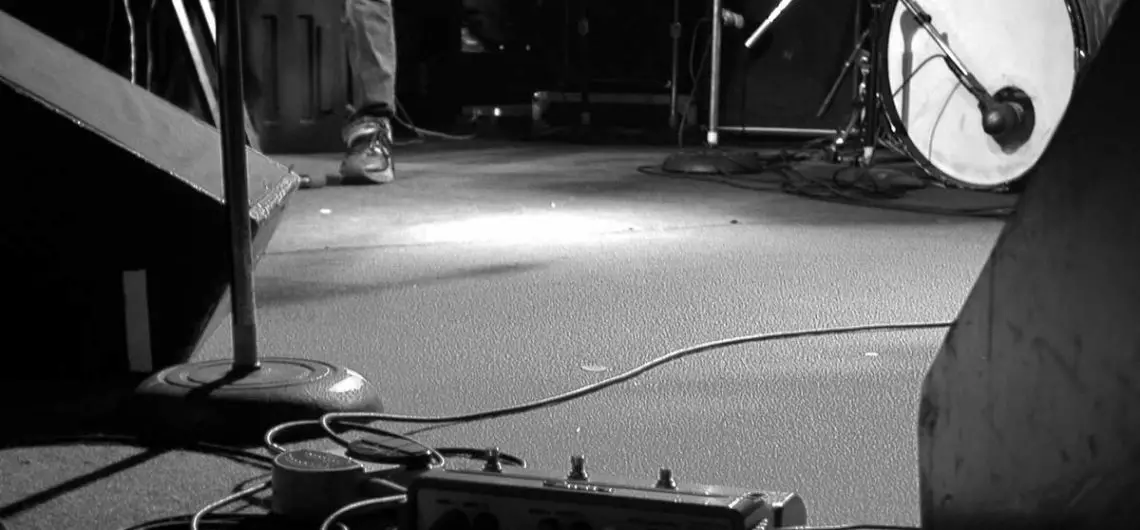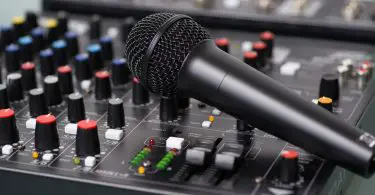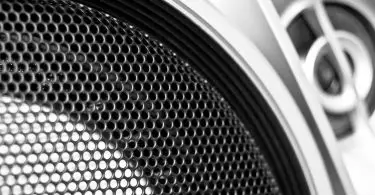The top onstage monitors are powerful, deliver the best sound quality and DSP, and work as a main if necessary. So keep reading to find out what to look for in a stage monitor, the top recommendation, and other decent monitor choices. It isn’t easy to find the right fit. But buying the wrong monitor can be an expensive mistake. Here’s how to find the best onstage monitor for your needs.
The Winner of the Top Onstage Monitors: The QSC K12 is a powerful stage monitor that delivers great sound quality and DSP, and works as a main if necessary.
To create this list of the top onstage monitors, it was necessary to try different stage monitors to narrow the list by trial and error. For this article, we looked at stage monitor options that were accessible, yet provided many variations for different needs.
What to Look For in an Onstage Monitor
There are important attributes that all onstage monitors should have. There are ways monitors differ, so you should consider your particular needs when reviewing this list. But this information will be helpful to most people who use onstage monitors.
Powered Vs. Unpowered Onstage Monitors
The biggest divide among onstage monitors is whether or not they have their own power source. Every sound source needs a boost in strength before the signal hits the speaker so it will be loud enough. In an unpowered monitor, the amplifier that provides this boost is separate.
With a powered one, the amp is inside the casing, so there’s no need to buy another. In general, powered monitors tend to cost more up-front compared to unpowered ones, but cost less than buying a monitor and amp combo. There are good options in both categories, although the best-powered monitors tend to have better sound quality and durability, as well as portability.
The best match for you depends on what you plan to do with the monitor and whether you already own a set of amps, as well as how much money you are willing to spend. Powered monitors are heavier, but unpowered ones require carrying two separate pieces.
In-Ear Vs. Stand-Alone Onstage Monitors
There is a big difference in how onstage monitors work. There are the classic onstage speakers that point at the band and there are the in-ear style ones. In-ear monitors are small earbuds that put the output directly in each band member’s ear. In-ears have a lot of special advantages.
First, if your equipment and mixer are good enough, you can send each band member a customized monitor track that helps them hear how their instrument is working in the mix. Second, in-ears can provide a more direct sound channel that won’t get lost among the instruments or the venue noise. However, in-ears are often more expensive and can be visually distracting.
They also might impose more wiring constraints on the band. Standalone monitors themselves come in different forms depending on where you plan to position them on stage. For example, there are the traditional wedge, larger fill-ins that stand off to the side and rack or stand-mounted monitors that can sit closer to the level of the musician’s ears.
There’s a lot of factors that determine the best onstage monitors for your needs, including:
- Whether you go on tour or not.
- The composition of the band.
- Which instruments and how many you use.
- The size of the venue or venues you usually play.
Stage Monitor Capacity Concerns
Whether you choose unpowered or powered stage monitors, you will find the size and ability of the monitor to project sound will make a big difference. If you play in big venues or deal with a lot of sound, you will need a bigger monitor.
For both powered and unpowered models the preferred measure is watts, with more wattage indicating higher potential volume before distortion and other problems happen. In a powered monitor, the wattage refers to the power of the included amp. And for unpowered monitors, the wattage is an indicator of how powerful an amp you can connect to the monitor.
In general, more wattage is better because you can play at greater volumes without distortion, giving you a more useful range of volume. However, you generally also need to pay more for higher power, so don’t buy more than you need. The minimum useful watt rating is 100 to 125 watts, but you might need more according to your circumstances.
It may take some trial and error to decide the right amount of capacity your band needs. Unpowered monitors are more flexible in this regard because you can swap out the amp easily. Frequently, you will need different sizes for different instruments. For example, instruments that use more bass need more power.
Sound Quality is King in Onstage Monitors
Much goes into the quality of sound coming out of a speaker. A monitor should impart as little distortion and alteration to the sound as possible. This is because musicians need to get an accurate depiction of how the house hears their sound. There are many different characteristics that add up to the overall sound quality of a monitor.
Perhaps the most important is the frequency response. Onstage monitors need to be able to produce sound in the correct frequency over the entire range of your output. You can see the frequencies that you use from within your mixing and mastering software. Make sure you can find a monitor that will cleanly reach that entire range.
Otherwise, you’ll hear distortions, popping, clipping, and other effects creeping into the mix. Test different monitors to make sure they meet your needs ahead of time. Remember, you can’t always get all the information you need from just reading the specs online.
Onstage Monitors: Getting the Best Bang for Your Buck
Every musician knows how easy it is to overspend on gear. Onstage monitors can be quite expensive, especially if you have to buy a full set of them at the same time. For that reason, keep reading to learn about the stage monitor models that give you the most bang for your buck.
Although most high-end brands offer the best quality, the results don’t justify the price tag. So, it’s a good idea to set yourself a budget before starting your search. You can stay within your budget no matter how attractive the offerings are. If you compromise on your budget, you will inevitably be disappointed by the results, as well as be short of money.
If your budget doesn’t allow you to get a monitor that is acceptable, then save up more money and wait. Over time, newer and better monitors come out and older models drop in price, so your value will only increase. It may or may not be a good idea to try buy a used stage monitor. If you know nothing is wrong with the monitor, you can get a great deal on a used model that still works.
Our Recommendation: QSC K12
The QSC K12 Speakers are pricey, but the quality makes them worth the investment. It is a big, 2,000-watt speaker, so you can easily use them as mains in a larger indoor venue.
The Winner of the Top Onstage Monitors: The QSC K12 is a powerful stage monitor that delivers great sound quality and DSP, and works as a main if necessary.
In fact, some musicians use a couple of units as their mains and one more as the onstage monitor. It delivers excellent sound quality and a wide range of onboard mixing and EQ options. The field of sound is large and deep, covering a wide angle without any dead zones, overlap or variance.
The inputs include combo XLR/quarter-inch TRS and RCA phono, so you can use a full signal chain with a mixer. The outputs are dual XLR and XLR mix out. The onboard DSP governs two types of EQ. The high-frequency settings are “Vocal Boost,” which is a midrange booster and “Flat,” which preserves the source.
On the low end, you get “Normal” for the flattest response, “Deep” for extension of the bass, and “External Sub” if you want to connect an external subwoofer. It also has “GuardRail,” a feature that prevents clipping and popping. The QSC K12 weighs 39 pounds, which is light for its size, and you can play it vertically or as a wedge.
It is also easy to mount on a pole or stand for a wider coverage angle. The tough frame is aluminum, hardened plastic and steel. Although they geared the feature set toward being a main, the simple EQ and power make it a good monitor, as well. With a mixer, some mains, and one of these, you can run a band of any size. This is the high-water mark for stage monitors.
Runner-up: Peavey PV 12M
In the runner-up spot, there is a budget-friendly choice: the Peavey PV 12M. It’s a 12-inch monitor that goes for $200. This is a more traditional powered wedge monitor that can’t pass for a main, but you probably won’t need it to. It has two deployments: 30 degrees and 45 degrees.
You can also mount it on a pole and it rates at 500 watts. There are two quarter-inch inputs to let you fit it into your signal chain. This is clearly a different approach from the K10, but it makes more sense for many bands. Budget-wise it is very do-able and it functions exactly as it should, as a monitor.
Although there’s not much in the way of extra features, you get a clear, simple sound that consistently gives you the feedback you need. It’s tough enough to tour with and is a little heavier than the K10 at 41 pounds. From the floor, it is unobtrusive and easy to fit on stage. On a pole, it is even easier to use. You will benefit most from this monitor if all you need is a good, reliable speaker for any venue.
Honorable Mentions
Rockville RSM12A 12″

Credit: Rockville
The Rockville answer to the Peavey PV costs a little less. It’s still a 500-watt monitor, so not much has changed. However, it has only one input and one output. The input is line/mic and the output is a combo XLR-TRS. So you can do a little mixing or similar work, but that isn’t quite enough ports for some people.
Bass is excellent and provides a powerful tone without getting washed out or muddy.
It has a big 12-inch woofer that might be the highlight of the speaker. The bass is excellent and provides a powerful tone without getting washed out or muddy. This is a wedge stage monitor. There are indicators for LED power and for clipping. It comes with a three-band EQ and a filter for feedback.
The carpet and rubber feet help secure it in place and keep the frame off the floor. The RSM12A is tough, but a little heavy at 46 pounds. All in all, this is a slightly less expensive 500-watt monitor with a slightly smaller feature set, so it is what you would expect. The low end makes it good for heavy guitars, drums and similar instruments.
Samson RSXM10A
The RSXM10A are another choice on the budget end of the spectrum. These are considerably smaller onstage monitors. They are 10-inches, but are only rated for 800 watts, so they might have trouble cutting through in a loud venue like a crowded bar.
Good compact monitor for the money but with XLR, 1/4" I/O only
Perhaps the biggest upside to the SA-10Ms is their size. They weigh just 27.66 pounds each, they have a low profile, so they take up little room on stage and are easy to carry to gigs – while still being powered with an onboard amplifier. These onstage monitors also have a balanced frequency response, so they work for any instrument, vocals or drums. They are affordable, convenient and easy to transport.
If you perform outdoors and in smaller venues, such as at weddings, then consider the RSXM10A as a value buy. The low-price tag doesn’t mean the quality is low. In fact, these monitors are durable and deliver good sound quality. The RSXM10As are small and a lot less powerful than other options. Also, they don’t have output ports, DSP, or any other fancy features.
Behringer Eurolive VS1220F
The Behringer Eurolive VS1220F is a 150-watt monitor with a quarter-inch input and a wedge form factor. It is unpowered. The VS1220F has a single 12-inch driver for the bass and hardwired overload protection. This is a minimalist monitor.
Good minimalist monitor with good sound quality.
You will need to provide an amp to power it, but it doesn’t need much to drive it. This model is like the last one in that it has no extra features or special abilities. It has a particularly good sound quality for this price point, especially at the low end. So it works well for drums and other instruments that hang out in that part of the spectrum.
It’s great for bands, DJs, solo performers, and anyone else who is willing to hook it up to an amp or their main speakers and forget about it. Don’t expect it to cut through a lot of background noise. But for the price, you can outfit a band with a full set of monitors for less than you would spend on a single high-end stage monitor.
To recap, here’s the full competition:
The Winner of the Top Onstage Monitors: The QSC K12 is a powerful stage monitor that delivers great sound quality and DSP, and works as a main if necessary.
Bass is excellent and provides a powerful tone without getting washed out or muddy.
Good compact monitor for the money but with XLR, 1/4" I/O only
Good minimalist monitor with good sound quality.
















Start the discussion at talk.hearthemusicplay.com